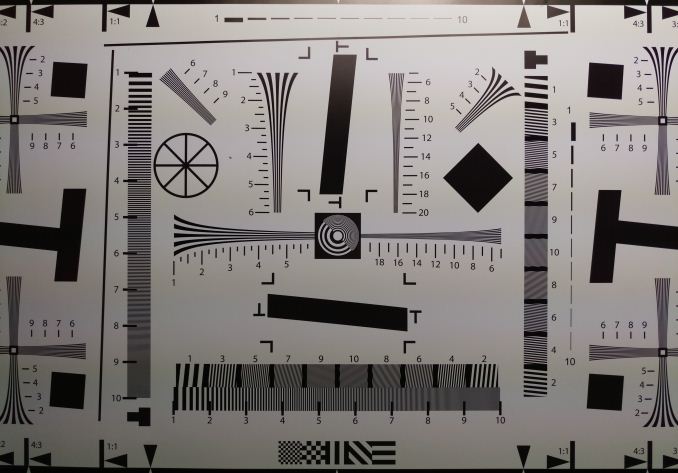The HTC One M9 Review: Part 2
by Joshua Ho on April 6, 2015 10:00 AM EST- Posted in
- Smartphones
- HTC
- Qualcomm
- Mobile
- Snapdragon 810
- One M9
Camera Performance
Now that we've finished going over the camera architecture and user experience of the One M9 we can talk about the end result, namely the quality of the still images and video that the One M9 can produce. Our first test is a basic test of spatial resolution, which uses high-contrast line pairs that make it possible to get a good idea for what the effective maximum resolution of the camera is.
In this test, we can see the benefits of the 20MP camera sensor of the One M9, spatial resolution in this test is a massive improvement over what we saw from the One M8. At the center, the resolution of the camera is sufficient to resolve up to the 20 mark. Resolution at the edges of the frame remains sufficiently high, with no obvious field curvature in this test. To get a more nuanced look of low ISO camera performance, we can look at some standard daytime shots to get a better idea of real-world camera performance.
Here we can start to see some of the real issues with the One M9's camera. It's immediately obvious that the sky here is just the wrong color. Although Los Angeles can be a smoggy place, the sky in this photo should be a stronger shade of blue, not gray with a tinge of blue. Looking at the texture of the roof, the grass throughout the photo, and the bleachers off in the distance, it's pretty obvious that HTC needs to strongly reduce the noise reduction that they're using here, as there's almost no detail in these photos. The detail is basically comparable to the iPhone 6's 8MP camera, which shouldn't be the case in these daytime conditions. The lack of shadow detail also degrades perceived quality. In general, the photo appears to be a bit underexposed as well.
With the HDR mode, all of the issues seen in auto mode are still present. However, to HTC's credit HDR mode is now usable instead of being almost useless as it was with the One M8. HTC still needs to focus on reducing halos as there seem to be issues with this on some high contrast edges/moving objects and make HDR a live preview similar to the Galaxy S5 and S6 camera, but in general this is a dramatic improvement when compared to previous devices.
In low light, the One M9 performs horribly. There's really not much else to be said because there's next to no detail in these photos. Noise reduction has smeared away what detail there was. Despite the fact that the photos have evidence of incredibly strong noise reduction, there's still a lot of noise visible in the image. Thankfully, the color noise of the image is low which makes things better, but for 1600 ISO and 1/9 second exposure time, the output is nothing to talk about.
Moving on the video quality, we can first look at 1080p30 quality. HTC uses a 20Mbps encode rate, using H.264 Baseline for video, and 192Kbps AAC for audio encoding. While the iPhone 6 can serve as a reasonable reference, there are a lot of apparent issues even if one doesn't look to the iPhone 6 for a point of comparison. In general, 1080p video doesn't seem to carry a great deal of detail with it, and it looks like there isn't any kind of video stabilization going on here. The result is that footage is extremely shaky and really kind of disappointing here.
For 1080p60 we can basically see the same story, as the One M9 still has a noticeable lack of detail and there are a lot of problems with camera shake that aren't dampened out. It almost looks like HTC doesn't have any kind of stabilization for video here, which is rather disappointing. The bitrate of 1080p60 footage is also unchanged from the 1080p30 settings, which is a bit curious.
For 720p120 slow motion, HTC does manage to capture real 720p footage instead of upsampled 480p video, and it compares favorably to the iPhone 6 but detail continues to be a problem here. The encoder settings are similar to 1080p30 with its H.264 Baseline setting, but bit rate is reduced to 12.1 Mbps.
Overall, the performance of the One M9's camera is disappointing. Overall, it's still probably better than the One M8's camera, but the execution is lacking. HTC needs to focus on improving detail by avoiding aggressive noise reduction, reduce aggressive sharpening, improve shadow detail, implement effective EIS and OIS, and work on improving auto-focus and capture latency. It's concerning that HTC still cannot come close to the competition in this area, and given that camera is a crucial aspect of any smartphone experience HTC needs to resolve all of these issues if they want to remain relevant in the smartphone market.






































127 Comments
View All Comments
Aenean144 - Monday, April 6, 2015 - link
I wonder if it's HTC chosen phone design architecture that's giving them troubles here, camera aside as who knows why that's been out of sorts.HTC sandwiches the battery between the LCD and the PCB (containing SoC, modem etc). This design is fine if all of the components hit their power envelopes, but everything is working against HTC here. When the SoC or wireless modem gets hot, the battery acts like a heat sink plus however much heat is taken out by the back casing.
Then, a quick charge where you're putting 10+ Watts into charging the battery is going to heat up that battery a bit.
Just seems like two bad things that can make things worse really fast. I imaging playing a game or doing something processor intensive while quick charging would not be a good thing to do here.
Despoiler - Monday, April 6, 2015 - link
I upgraded from an M7 to an M9. For me the camera is not so important because it all gets uploaded to social media. For me the killer features are the audio. I must have high audio quality from my phone. The M9 has amazing audio quality from all outputs (speaker or headphone). It's mind blowing how good it is. The Dolby mode has some serious mojo going on. It's comical how bad the Beats mode was compared to it. The Dolby mode is so good it works brilliantly on all types of music, which shouldn't be possible.Despoiler - Monday, April 6, 2015 - link
Also, where is the audio section of the review? Seriously how do you omit one of the biggest selling points of this phone?Dorek - Wednesday, April 8, 2015 - link
Yeah. I can excuse glossing over the external speakers for media, but not for speakerphone; that is a very, VERY important thing to consider. And to not test the headphone output is also very stupid.Digekari - Monday, April 6, 2015 - link
What about the internal audio? I was really interested in that.TallestJon96 - Monday, April 6, 2015 - link
So the m9 is WORSE than the m8? That's a shame, as I almost purchased an m8, and was hoping a future model could replace my iPhone, but if they are getting worse, than I'll stay away.cryosx - Monday, April 6, 2015 - link
I have a feeling we're going to need to disable 4 cores, that'll make it run like the S801 and hopefully reign in on excessive heat. Maximum performance will suffer but battery life will hopefully return to M8 levels and or surpass it.melgross - Monday, April 6, 2015 - link
I don't understand this 8 core crap. Two or three years ago, it might have made sense to have four weak, but low power cores for much of the work, and four high end cores for the latest games, camera processing, etc.But that never really worked out that well. When Samsung decided to use all eight at the same time, it was a really dumb idea. Not only are the two core types of differently strengths, but they also have slightly different instruction sets. And as we've already seen in at least one review, sometimes going to the weak cores uses more battery power than using the strong cores because of the time of processing, and other constraints of these cores.
And using all eight at the same time often results in slower processing because the two core sets can't process exactly the same way, and things get jammed up.
The problem here is that some manufacturers are just thinking of marketing. It's just SO much better to advertise 8 cores than 4. But Apple gets better performance out of three!
Something's got to give. They should just drop the weak cores altogether, and work on making the four strong cores better, and more efficient.
TrojMacReady - Saturday, April 11, 2015 - link
Just no.The current 7420 Exynos gets better performance than any A8 smartphone SoC (at the same resolution) all around. In practise (except gaming at native resolution) too, despite pushing many more pixels (up to a factor 3.7).
As for a comparison to the A8X, that's flawed in so many ways. Its TDP is up to twice as high and it's almost twice as large too. People are already complaining about the heat it produces in a large iPad, consider it sitting in a smartphone... The 7420 CPU outpaces it, despite the above differences, the GPU is 10-20% slower. But with much less power consumption and heat as a bonus. I guess those 8 cores aren't so bad afterall.
mrochester - Monday, April 6, 2015 - link
The Android death knell sounds. This is what happens when you use the same software and ecosystem as your competitors.